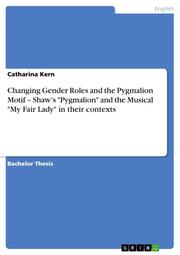Detailansicht
Changing Gender Roles and the Pygmalion Motif - Shaws 'Pygmalion' and the Musical 'My Fair Lady' in their contexts
ISBN/EAN: 9783640497720
Umbreit-Nr.: 3423729
Sprache:
Englisch
Umfang: 56 S.
Format in cm: 0.5 x 21 x 14.8
Einband:
kartoniertes Buch
Erschienen am 21.12.2009
Auflage: 1/2009
- Zusatztext
- Bachelor Thesis from the year 2007 in the subject English Language and Literature Studies - Literature, grade: 2,0, University of Bayreuth, language: English, abstract: Pygmalion is one of the most famous comedies of all times. Its mythological background is fascinating as the topic is still up to date. This is why it has influenced many artists to use the story for their works. Besides Ovids version in his Metamorphoses that very closely sticks to the original of Greek mythology and G. B. Shaws one that, although he changes the frame and the plot of Pygmalion, he still holds on to the idea of the original story, there is for example Jean-Jacques Rousseaus melodrama Pygmalion (1770), Johann Wolfgang Goethes poem Pygmalion (1767) and Franz von Suppés operetta Die Schöne Galathee (1865). The mythological background, though, is not the only reason why the story of Pygmalion has attracted that many artists and is that popular. It is the diversity of its themes and actions. There is for example a love story, a criticism of society, many different characters that are interesting in each way, changes in individual personalities and so on. . . . In a way he also forms a woman after his ideas and taste. This point of shaping a woman is present in both, Ovids Metamorphoses and G. B. Shaws Pygmalion. However, the most important difference between them is the womans behaviour. While in mythology Galatea is only a passive character, in Shaws Pygmalion Eliza is active from the beginning on and influences the plays stream and action. She takes her destiny into her own hands and one could speak of an emancipated woman. As emancipation was a major topic and drastically developed during the Victorian era, one could argue whether the description of women in literature actually reflects societys attitude towards them in the era in which this literature was written. For this reason I will elaborate the role of women in Victorian society in general and in Pygmalion in specific. Furthermore I would like to compare the play Pygmalion, which was staged for the first time in 1913, to the musical My fair lady which was released in 1956. The difference in time promises a difference in the reception of the story and it is probable that the changes in society between 1913 and 1956 are reflected in those two versions.Especially the role of women changed in those years. Therefore the focus of my thesis will be these transforming ideas concerning women in the Victorian age and the 1950s by means of Pygmalion and My fair lady.
